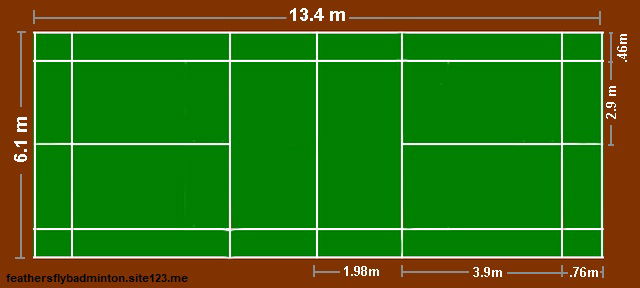Badminton Rules..

Badminton is a sport that has been around since the 16th century. The sport is played indoors and the pinnacle comes from its Olympic events. The sport is very popular in Asian countries such as China and India with these countries leading the way by producing some of the world’s best players.
Just like other sports, badminton also has its own unique badminton rules and these rules or what some call policies should be followed by everyone especially those who wish to participate in tournaments or competitions. Examples of these laws, we will discuss, are laws about badminton court dimensions, badminton equipment, badminton scoring and the Badminton serve or service.

To begin with, I will first discuss the badminton court dimensions Law. The Badminton court should be a rectangular court which should be divided into two halves by a net at its centre. The full width of the badminton court is 6.1 meters (20 ft) and the full length of the court is 13.4 meters (44 ft). However, in singles its width is reduced to 5.18 meters (17 ft). On both sides of the court, the area for service is also divided. This line division has a distance of 1.98 meters (6 ft 6 inches) from the net, the outer side and the back boundaries of the court. Moreover, in a doubles game, the division of the service line is 0.76 meters (2 ft 6 inch) from the back boundary. The net which is placed in the centre of the court is 1.55 meters (5 ft 1 inch) high at the end points and 1.524 metres (5 ft) high in the centre. Furthermore, the net posts are placed over the doubles sidelines even when the game being played is singles.
Next I will discuss the badminton equipment Law. These laws refer to the design and size of the badminton equipment to be used. Specifically the badminton racquets, as well as on the birdies or what we call shuttlecocks. By law, badminton racquets should weigh between 75 and 95 grams (2.6 to 3.3 ounces) including the strings. These badminton racquets have the traditional oval head shape as well as the increasingly common shape in new racquets which is the isometric head shape. In like manner, best led shuttlecocks also have their own standards. It is usually tested in terms of its correct speed. To test a shuttlecock, they usually use a full underhand stroke which makes contact with the shuttlecock over the back of the boundary line. Thus the shuttlecock shall be hit at an upward angle and in a direction parallel to the side lines. Also, the shuttlecock of the correct speed should land in not less than 530 mm and not more than 990 mm short of the other back of the boundary line.
have the best smile quotes caption here.
For the scoring system and service laws there are three sub laws under its category. These are the basics, details and the lets. First I will talk about the basics. Each badminton game is played up to 21 points with players scoring a point whenever they win a rally regardless of whether they made the service or not. Usually a match is best of three games. The rally starts with the server, and the receiver stands in the diagonally opposite service court. The server should hit the shuttlecock and have it land on the receiver’s service court. When the servers’ side loses a rally, the next service will be immediately passed to the other opponent. In a singles game, the server stands in her/his right service court if the score is even and on the left service court if the score is odd. Moreover, in a game of doubles, if the serving side wins a rally, the same player continues to serve but she changes his/her service court so that he/she could serve it to a different opponent each time. Furthermore, if the opponent wins the rally and their score is even, the player in the right service court will do the service. However, if the score is odd, then the player in the left service court will do the service. It is important to keep in mind that the players’ service courts are determined by their position at the start of the previous rally and not by where they were standing at the end of the rally. In consequence of this system, each time a team regains the service, the server will be the player who did not served last time.



